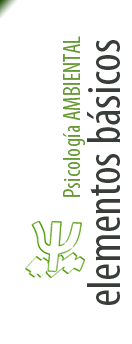Bibliografía
REFERENCIAS BIBLIOGRÁFICAS
Aragonés, J.I. (1998) Cognición Ambiental. En J.I. Aragonés y M. Amérigo (Comp.) Psicología Ambiental. Madrid: Pirámide, pp. 43-58.
Aragonés, J.I. & Arredondo, J.M. (1985) Structure of Urban Cognitive Maps. Journal of Environmental Psychology, 5, 197-212.
Banerjee, T. & Southworth, M. (Eds.) (1990). City Sense and City Design. Writings and Projects by Kevin Lynch. Cambridge (Mass.): MIT Press
Bechtel, R.B. (1997). Environment & Behavior. An Introduction. Thousand Oaks (Ca.): Sage Publications.
Bell, P.A., Fisher, J.D., Baum, A. & Greene, Th.C. (1996). Environmental Psychology, cuarta edición. Fort Worth: Harcourt Brace.
Bruner, J. & Goodman, (1947) Value and Need as Organizing Factors in Perception. Journal of Abnormal and Social Psychology, 42, 33-44.
Downs, R.M. & Stea, D. (Eds.)(1973) Image and Environment: Cognitive Mapping and Spatial Behavior. Chicago: Aldine.
Gärling, T., Book, A. & Lindberg, E. (1986). Spatial orientation and wayfinding in the designed environment: A conceptual analysis and some suggestions for postocupancy evaluation. Journal of Architectural and Planning Research, 3, 55-64.
Hart, R. & Moore, G.T. (1973) The development of spatial cognition: A review. In R.M. Downs & D. Stea (Eds.) Image and Environment: Cognitive Mapping and Spatial Behavior. Chicago: Aldine.
Hernández, B. y Carreiras, M. (1986) Métodos de investigación en mapas cognitivos. En F. Jiménez Burillo y J.I. Aragonés (eds.) Introducción a la Psicología Ambiental. Madrid: Alianza.
Holahan, Ch.J. (1991). Psicología Ambiental. Un enfoque general. México: Limusa (Original en inglés en Random House, 1982).
Lee, T.R. (1976) Psychology and the Environment. London: Methuen Co. Traducido Psicología y Medio Ambiente, Barcelona: CEAC, 1981.
Levine, M. (1982) You-are-here maps: Psychological considerations. Environment and Behavior, 14, 221-237.
Levine, M. (1984)
Lynch, K. (1960) The Image of the City. Cambridge (Mass.): MIT Press. Traducido en Barcelona: Gustavo Gili, 1984.
Lynch, K. (1985) Reconsidering the Image of the City. En Lloyd Rodwin & Robert Hollister (Eds.), Cities of the Mind. New York: Plenum Press.
Milgram, S. (1977). Cities
Miller, G.A. (1956) The Magical Number Seven, Plus or Minus Two: Some Limits on our Capacity for Processing
Information. Psychological Review, 63, 81-97.
Muntañola, J. (1987)
Rivière, A. (1991). Objetos con mente. Madrid: Alianza.
Tolman, E.C. (1948) Cognitive maps in rats and men. Psychological Review, 55, 189-208.
Trowbridge, C.C. (1913) On fundamental methods of orientation and "Imaginary Maps". Science, XXXVIII, 888-897.
BIBLIOGRAFÍA BÁSICA
Aragonés, J.I. y Amérigo, M. (Comps.) Psicología Ambiental. Madrid: Pirámide.
El capítulo 2, escrito por el propio Juan Ignacio Aragonés, está dedicado a la Cognición Ambiental.
BIBLIOGRAFÍA RECOMENDADA
Bechtel, R.B. (1997). Environment & Behavior. An Introduction. Thousand Oaks (Ca.): Sage Publications.
El capítulo 6 está dedicado al tema con el título Environmental Cognition. Destaca especialmente el abordaje de los temas correspondientes a wayfindings, percepción de distancias y You-Are-Here-Maps.
Bell, P.A., Fisher, J.D., Baum, A. & Greene, Th.C. (1996). Environmental Psychology, cuarta edición. Fort Worth: Harcourt Brace.
En su tercer capítulo titulado Environmental perception and cognition, y especialmente en las páginas 77-106, este manual trata de forma muy completa el tema de la cognición ambiental, tanto desde la perspectiva de los mapas cognitivos como el tema de wayfinding. Esquemas e ilustraciones permiten acceder fácilmente a los contenidos.
Gifford, R. (1987). Environmental Psychology. Principles and Practice. Boston: Allyn and Bacon.
El segundo capítulo aborda la percepción y la cognición espacial. Para este tema resulta interesante la parte dedicada a cognición (páginas 29-45) con una completa revisión de los principales contenidos del tema.
Lynch, K. (1960) The Image of the City. Cambridge (Mass.): MIT Press. Traducido en Barcelona: Gustavo Gili, 1984.
Un libro sencillo, breve, accesible y, por supuesto, la base principal en el desarrollo de la cognición ambiental. Todo un clásico.

 Volver a 3.4
Volver a 3.4


 Els continguts del web CRAI UB estan subjectes a la
Els continguts del web CRAI UB estan subjectes a la